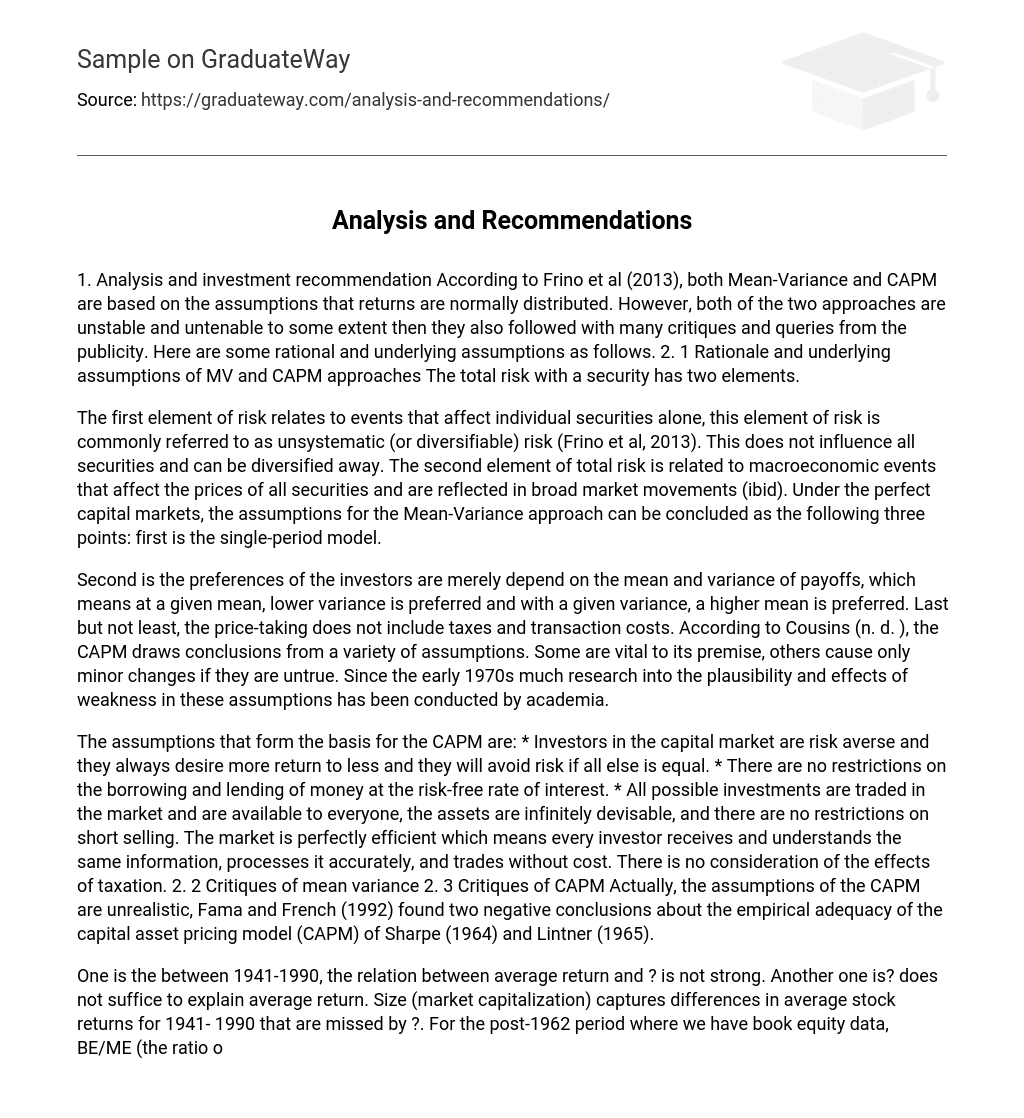1. Analysis and investment recommendation According to Frino et al (2013), both Mean-Variance and CAPM are based on the assumptions that returns are normally distributed. However, both of the two approaches are unstable and untenable to some extent then they also followed with many critiques and queries from the publicity. Here are some rational and underlying assumptions as follows. 2. 1 Rationale and underlying assumptions of MV and CAPM approaches The total risk with a security has two elements.
The first element of risk relates to events that affect individual securities alone, this element of risk is commonly referred to as unsystematic (or diversifiable) risk (Frino et al, 2013). This does not influence all securities and can be diversified away. The second element of total risk is related to macroeconomic events that affect the prices of all securities and are reflected in broad market movements (ibid). Under the perfect capital markets, the assumptions for the Mean-Variance approach can be concluded as the following three points: first is the single-period model.
Second is the preferences of the investors are merely depend on the mean and variance of payoffs, which means at a given mean, lower variance is preferred and with a given variance, a higher mean is preferred. Last but not least, the price-taking does not include taxes and transaction costs. According to Cousins (n. d. ), the CAPM draws conclusions from a variety of assumptions. Some are vital to its premise, others cause only minor changes if they are untrue. Since the early 1970s much research into the plausibility and effects of weakness in these assumptions has been conducted by academia.
The assumptions that form the basis for the CAPM are: * Investors in the capital market are risk averse and they always desire more return to less and they will avoid risk if all else is equal. * There are no restrictions on the borrowing and lending of money at the risk-free rate of interest. * All possible investments are traded in the market and are available to everyone, the assets are infinitely devisable, and there are no restrictions on short selling. The market is perfectly efficient which means every investor receives and understands the same information, processes it accurately, and trades without cost. There is no consideration of the effects of taxation. 2. 2 Critiques of mean variance 2. 3 Critiques of CAPM Actually, the assumptions of the CAPM are unrealistic, Fama and French (1992) found two negative conclusions about the empirical adequacy of the capital asset pricing model (CAPM) of Sharpe (1964) and Lintner (1965).
One is the between 1941-1990, the relation between average return and ? is not strong. Another one is? does not suffice to explain average return. Size (market capitalization) captures differences in average stock returns for 1941- 1990 that are missed by ?. For the post-1962 period where we have book equity data, BE/ME (the ratio of book to market equity) and other variables also help explain average return (Fama et al, 1996). CAPM approach was developed from MV approach and it assumes that all investors are risk averse, which is so absolute.
Most of the investors are risk averse but some of them will likely to take the risks to gain profit. Frino (2013) demonstrates that unsystematic risk can be eliminated by combining a security in a large portfolio. Under CAPM approach, this point has been ignored and investors only require a rate of return for the systematic risk of their portfolio (Brealey et al. , 2007). The unlimited risk-free borrowing and lending assumption is unrealistic. However this assumption is dropped in the BLACK CAPM. Neutral taxes do not exist.
Investors and investments do not face the same tax rates. For example the dividend upper rate vs. the ordinary rate. All investors do not optimize a mean-variance objective such as noise traders who invest irrationally. The homogenous belief assumption is therefore also violated. The sole intention of the model is to provide a guide for investment via an assets required risk premium. These unrealistic assumptions could result in the failure of this. Beta may therefore not be significantly different from zero. http://www. eferenceforbusiness. com/encyclopedia/Bre-Cap/Capital-Asset-Pricing-Model-CAPM. html 2. 4 Investment recommendation Brealey, R. A. , Myers, S. C. & Marcus, A. J. (2007) Fundamentals of Corporate Finance. 5th ed. New York, McGraw-Hill/Irwin. Frino, A. et al. 2013, Introduction to Corporate Finance. 5th ed, Pearson, Australia Fama, E. 1996, ‘The CAPM is Wanted, Dead or Alive’, The Journal of Finance, Vol. 51, No. 5 (Dec. , 1996), pp. 1947-1958 Joan K. Cousins n. d. , Capital asset pricing model. Reference for business, viewed 26 April 2013,





